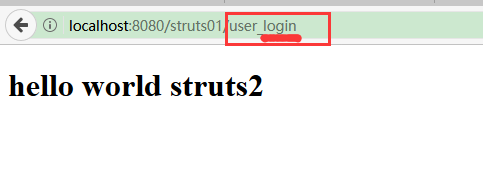Struts2的动态Action和全局跳转视图以及配置各项默认值
1:Struts2的默认访问后缀是.action(特别需要注意的是改了配置文件web.xml或者struts.xml需要重启服务器)

2:Struts2中常用的常量介绍:
<!-- 一:全局配置 -->
<!--1.请求数据编码 -->
<constant name="struts.i18n.encoding" value="UTF-8"/>
<!--2.修改struts2默认的自定义后缀 -->
<constant name="struts.action.extension" value="action,do,"/>
<!--3.设置浏览器是否缓存静态内容,默认值为true(生产环境下使用),开发阶段最好关闭 -->
<constant name="struts.serve.static.browserCache" value="false"/>
<!--4.当struts的配置文件修改后,系统是否自动重新加载该文件,默认值为false(生产环境下使用),开发阶段最好打开 -->
<constant name="struts.configuration.xml.reload" value="true"/>
<!--5.开发模式下使用,这样可以打印出更详细的错误信息 -->
<constant name="struts.devMode" value="true" />
<!--6.默认的视图主题 -->
<constant name="struts.ui.theme" value="simple" />
<!--7.与spring集成时,指定由spring负责action对象的创建 -->
<constant name="struts.objectFactory" value="spring" />
<!--8.该属性设置Struts 2是否支持动态方法调用,该属性的默认值是true。如果需要关闭动态方法调用,则可设置该属性为 false -->
<constant name="struts.enable.DynamicMethodInvocation" value="true"/>
<!--9.上传文件的大小限制 -->
<constant name="struts.multipart.maxSize" value="10701096"/>
3:Struts2的动态Action的简单应用和多个.xml的使用:
第一步:引包,略去
第二步:配置web.xml
1 <?xml version="1.0" encoding="UTF-8"?> 2 <web-app xmlns:xsi="http://www.w3.org/2001/XMLSchema-instance" xmlns="http://java.sun.com/xml/ns/javaee" xsi:schemaLocation="http://java.sun.com/xml/ns/javaee http://java.sun.com/xml/ns/javaee/web-app_3_0.xsd" id="WebApp_ID" version="3.0"> 3 <display-name>struts2_20170219</display-name> 4 <welcome-file-list> 5 <welcome-file>index.html</welcome-file> 6 <welcome-file>index.htm</welcome-file> 7 <welcome-file>index.jsp</welcome-file> 8 <welcome-file>default.html</welcome-file> 9 <welcome-file>default.htm</welcome-file> 10 <welcome-file>default.jsp</welcome-file> 11 </welcome-file-list> 12 13 <!-- 引入struts2的核心过滤器 --> 14 <filter> 15 <!-- 过滤器的名称 --> 16 <filter-name>struts2</filter-name> 17 <!-- 过滤器类 --> 18 <filter-class>org.apache.struts2.dispatcher.ng.filter.StrutsPrepareAndExecuteFilter</filter-class> 19 </filter> 20 <filter-mapping> 21 <!-- 过滤器名称 --> 22 <filter-name>struts2</filter-name> 23 <!-- 过滤器映射 --> 24 <url-pattern>/*</url-pattern> 25 </filter-mapping> 26 </web-app>
第三步:开发第一个Action,配置第一个struts01.xml文件
1 package com.bie.struts01; 2 3 import com.opensymphony.xwork2.ActionSupport; 4 5 /** 6 * @author BieHongLi 7 * @version 创建时间:2017年2月19日 下午3:08:53 8 * 开发action,处理请求 9 */ 10 public class HelloAction extends ActionSupport{ 11 12 private static final long serialVersionUID = 1L; 13 14 /** 15 * 重写execute,处理请求的方法 16 */ 17 @Override 18 public String execute() throws Exception { 19 System.out.println("访问到了action,正在 处理请求"); 20 System.out.println("hello world!!! struts2"); 21 return SUCCESS; 22 } 23 24 }
1 <?xml version="1.0" encoding="UTF-8" ?> 2 <!DOCTYPE struts PUBLIC 3 "-//Apache Software Foundation//DTD Struts Configuration 2.0//EN" 4 "http://struts.apache.org/dtds/struts-2.0.dtd"> 5 6 <struts> 7 <!-- 声明包 --> 8 <package name="helloPackage" abstract="false" extends="struts-default"> 9 <action name="helloAction" class="com.bie.struts01.HelloAction"> 10 <result name="success">success.jsp</result> 11 </action> 12 </package> 13 14 15 </struts>
第四步:开发第二个Action,配置第二个struts02.xml文件
1 package com.bie.struts02; 2 3 import com.opensymphony.xwork2.ActionSupport; 4 5 /** 6 * @author BieHongLi 7 * @version 创建时间:2017年2月20日 下午4:05:38 8 * 9 */ 10 public class TestAction extends ActionSupport{ 11 12 private static final long serialVersionUID = 1L; 13 14 public String test(){ 15 System.out.println("测试的方法!!!"); 16 return SUCCESS; 17 } 18 19 }
1 <?xml version="1.0" encoding="UTF-8" ?> 2 <!DOCTYPE struts PUBLIC 3 "-//Apache Software Foundation//DTD Struts Configuration 2.0//EN" 4 "http://struts.apache.org/dtds/struts-2.0.dtd"> 5 6 <struts> 7 <!-- 声明包 --> 8 <package name="testPackage" abstract="false" extends="struts-default"> 9 <!-- 动态方法调用的格式如:http://localhost:8080/struts2_20170219/testAction!test --> 10 <action name="testAction" class="com.bie.struts02.TestAction"> 11 <result name="success">success.jsp</result> 12 </action> 13 </package> 14 15 16 </struts>
第五步:配置struts2的全局变量以及总struts.xml文件;
需要注意的是动态Action默认是不使用的,将false改为true即可使用动态Action。
<?xml version="1.0" encoding="UTF-8" ?> <!DOCTYPE struts PUBLIC "-//Apache Software Foundation//DTD Struts Configuration 2.0//EN" "http://struts.apache.org/dtds/struts-2.0.dtd"> <struts> <!-- 一:全局配置 --> <!--1.请求数据编码 --> <constant name="struts.i18n.encoding" value="UTF-8"/> <!--2.修改struts2默认的自定义后缀 --> <constant name="struts.action.extension" value="action,do,"/> <!--3.设置浏览器是否缓存静态内容,默认值为true(生产环境下使用),开发阶段最好关闭 --> <constant name="struts.serve.static.browserCache" value="false"/> <!--4.当struts的配置文件修改后,系统是否自动重新加载该文件,默认值为false(生产环境下使用),开发阶段最好打开 --> <constant name="struts.configuration.xml.reload" value="true"/> <!--5.开发模式下使用,这样可以打印出更详细的错误信息 --> <constant name="struts.devMode" value="true" /> <!--6.默认的视图主题 --> <constant name="struts.ui.theme" value="simple" /> <!--7.与spring集成时,指定由spring负责action对象的创建 --> <constant name="struts.objectFactory" value="spring" /> <!--8.该属性设置Struts 2是否支持动态方法调用,该属性的默认值是true。如果需要关闭动态方法调用,则可设置该属性 为 false --> <constant name="struts.enable.DynamicMethodInvocation" value="true"/> <!--9.上传文件的大小限制 --> <constant name="struts.multipart.maxSize" value="10701096"/> </struts>
1 <?xml version="1.0" encoding="UTF-8" ?> 2 <!DOCTYPE struts PUBLIC 3 "-//Apache Software Foundation//DTD Struts Configuration 2.0//EN" 4 "http://struts.apache.org/dtds/struts-2.0.dtd"> 5 6 <struts> 7 8 <!-- Struts2的全局配置,必须写在最上面,格式如下所示 --> 9 <include file="constant.xml"></include> 10 11 <!-- 总配置文件,引入其他所有的配置文件 ,引入其他的配置文件需要注意的是/不是. --> 12 <include file="com/bie/struts01/struts01.xml"></include> 13 <include file="com/bie/struts02/struts02.xml"></include> 14 15 16 </struts>
运行效果如下所示:(注意:动态Action的访问是action的name属性加!后面是方法名即可访问。)详细如下图所示:



4:配置各项默认值:详解如下所示 配置全局跳转视图,先去action的result找,如果没有就去全局视图找:
<global-results> <result name="success">success.jsp</result> </global-results>
1 <?xml version="1.0" encoding="UTF-8" ?> 2 <!DOCTYPE struts PUBLIC 3 "-//Apache Software Foundation//DTD Struts Configuration 2.0//EN" 4 "http://struts.apache.org/dtds/struts-2.0.dtd"> 5 6 <struts> 7 <!-- 声明包 --> 8 <package name="helloPackage" abstract="false" extends="struts-default"> 9 <!-- 配置全局跳转视图 --> 10 <global-results> 11 <result name="success">success.jsp</result> 12 </global-results> 13 14 <action name="helloAction" class="com.bie.HelloAction"> 15 <!-- <result name="success">success.jsp</result> --> 16 </action> 17 18 <action name="worldAction" class="com.bie.WorldAction"> 19 <!-- <result name="success">success.jsp</result> --> 20 <!-- 返回结果标记success对应的页面在当前action中没有配置,那么会 21 会去找全局配置是否有success标记对应的页面 ,如果全局配置也没有 22 success标记对应的页面,那么就报404错误。--> 23 </action> 24 25 26 <!-- 配置各项默认值 --> 27 <!-- 28 1:name 只配置了访问路径名称 29 2:class 默认执行得action在struts-default有配置 30 <default-class-ref class="com.opensymphony.xwork2.ActionSupport" /> 31 3:method默认是execute 32 默认得方法execute返回值为success,对应页面去全局视图找, 33 如果全局试图没,那么报404错误。 34 --> 35 <action name="test01"></action> 36 </package> 37 38 39 </struts>
5:Struts2的Action的开发的几种方式
(1):方式一,继承ActionSupport,最经常使用的。
如果用struts的数据校验功能,必须继承此类;
(2):方式二,实现Action接口
(3):方式三,手动写;
6:使用通配符进行配置Action(在struts中配置信息中,可以用*和{1}优化配置;),如下所示:
1 package com.bie.lesson03; 2 3 import com.opensymphony.xwork2.ActionSupport; 4 5 /** 6 * @author Author:别先生 7 * @date Date:2017年9月10日 下午10:22:34 8 * 9 * 10 */ 11 public class StrutsConfig extends ActionSupport{ 12 13 /** 14 * 15 */ 16 private static final long serialVersionUID = 1L; 17 18 public String login() { 19 20 System.out.println("模拟的登陆的方法"); 21 22 return SUCCESS; 23 } 24 25 public String register(){ 26 27 System.out.println("模拟的注册的方法"); 28 29 return SUCCESS; 30 } 31 32 }
然后配置strutsConfig.xml配置文件,注意这里的Action使用了占位符进行配置:
1 <?xml version="1.0" encoding="UTF-8" ?> 2 <!DOCTYPE struts PUBLIC 3 "-//Apache Software Foundation//DTD Struts Configuration 2.0//EN" 4 "http://struts.apache.org/dtds/struts-2.0.dtd"> 5 6 <struts> 7 <!-- 声明包 --> 8 <package name="strutsPackage03" extends="struts-default"> 9 <!-- 10 定义action 11 name:访问路径 12 class:类的路径 13 method:方法名称 14 --> 15 <action name="user_*" class="com.bie.lesson03.StrutsConfig" method="{1}"> 16 <result name="success">success.jsp</result> 17 </action> 18 19 </package> 20 21 </struts>
然后在总的配置文件struts.xml中引入配置文件strutsConfig.xml即可,如下所示:
1 <?xml version="1.0" encoding="UTF-8" ?> 2 <!DOCTYPE struts PUBLIC 3 "-//Apache Software Foundation//DTD Struts Configuration 2.0//EN" 4 "http://struts.apache.org/dtds/struts-2.0.dtd"> 5 6 <struts> 7 <!-- struts在允许的时候会加载这个总配置文件:src/struts.xml --> 8 9 <!-- 在总配置文件中引入其他所有的配置文件 --> 10 11 <include file="com/bie/lesson03/strutsConfig.xml"></include> 12 </struts>
访问的时候如下所示:
对比一下可以很清晰的发现他们之间的区别,这就是使用了占位发简化开发;

7:Struts的常量
Struts1中默认访问后缀是*.do
Struts2中默认访问后缀是*action
如何修改默认访问后缀:
(1):Struts的访问后缀在哪里定义:
在default.properties文件中
默认访问后缀:struts.action.extension=action,,
1 <?xml version="1.0" encoding="UTF-8" ?> 2 <!DOCTYPE struts PUBLIC 3 "-//Apache Software Foundation//DTD Struts Configuration 2.0//EN" 4 "http://struts.apache.org/dtds/struts-2.0.dtd"> 5 6 <struts> 7 <!-- struts在允许的时候会加载这个总配置文件:src/struts.xml --> 8 9 <!-- 全局配置 --> 10 <!-- 修改Struts的默认访问后缀 --> 11 <constant name="struts.action.extension" value="action,do,struts"></constant> 12 13 14 </struts>
8:配置的顺序书写,?代表0或者1,*代表0或者多:
The content of element type "package" must match "(
result-types?,
interceptors?,
default-interceptor-ref?,
default-action-ref?,
default-class-ref?,
global-results?,
global-exception-mappings?,
action*)".





【推荐】国内首个AI IDE,深度理解中文开发场景,立即下载体验Trae
【推荐】编程新体验,更懂你的AI,立即体验豆包MarsCode编程助手
【推荐】抖音旗下AI助手豆包,你的智能百科全书,全免费不限次数
【推荐】轻量又高性能的 SSH 工具 IShell:AI 加持,快人一步
· 如何编写易于单元测试的代码
· 10年+ .NET Coder 心语,封装的思维:从隐藏、稳定开始理解其本质意义
· .NET Core 中如何实现缓存的预热?
· 从 HTTP 原因短语缺失研究 HTTP/2 和 HTTP/3 的设计差异
· AI与.NET技术实操系列:向量存储与相似性搜索在 .NET 中的实现
· 周边上新:园子的第一款马克杯温暖上架
· Open-Sora 2.0 重磅开源!
· 分享 3 个 .NET 开源的文件压缩处理库,助力快速实现文件压缩解压功能!
· Ollama——大语言模型本地部署的极速利器
· DeepSeek如何颠覆传统软件测试?测试工程师会被淘汰吗?